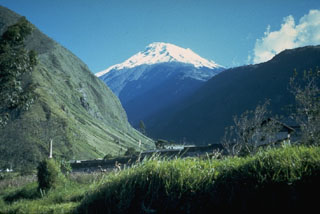Report on Tungurahua (Ecuador) — 6 February-12 February 2008
Smithsonian Institution / US Geological Survey
Weekly Volcanic Activity Report, 6 February-12 February 2008
Managing Editor: Sally Sennert.
Please cite this report as:
Global Volcanism Program, 2008. Report on Tungurahua (Ecuador) (Sennert, S, ed.). Weekly Volcanic Activity Report, 6 February-12 February 2008. Smithsonian Institution and US Geological Survey.
Tungurahua
Ecuador
1.467°S, 78.442°W; summit elev. 5023 m
All times are local (unless otherwise noted)
On 6 February, IG reported that pyroclastic flows from Tungurahua descended multiple NW and W drainages and tephra fall 3 cm in diameter was reported in areas to the SW. Based on information from the IG and satellite imagery evaluation, the Washington VAAC reported that ash plumes rose to estimated altitudes of 7.3-14.3 km (24,000-47,000 ft) a.s.l. and drifted S and NW. Ashfall was reported in areas downwind and to the SW and W, including Riobamba (30 km S). Precursory seismicity saturated local stations and presented similar patterns seen prior to intense episodes in July and August 2006. According to news articles, several hundred to 2,000 people were evacuated.
On 7 February, ash plumes rose to altitudes of 7-10 km (23,000-32,800 ft) a.s.l. and drifted mainly NW. Ash and tephra fell in areas to the SW and W. Strong roaring noises, explosions, and "cannon shots" were heard and windows vibrated, as far away as the Tungurahua Observatory (OVT) in Guadalupe, about 13 km NW. Incandescent material was propelled from the summit and fell on the flanks at about 3.5 km elevation, below the crater. Pyroclastic flows were detected in the Chontapamba ravine to the W and in the Juive and Mandur drainages to the NW. According to news articles, residents were evacuated again, hours after being allowed to return home.
During 8-11 February, ash plumes rose to altitudes of 6-10 km (19,700-32,800 ft) a.s.l. and drifted mainly W and E (on 10 February, only). Ashfall was reported from areas to the NW, W, and SW and was 3-4 mm thick in Choglontus to the SW on 8 February. Incandescence at the summit was also observed on 8 February. Ground vibrations were reported all four days. On 11 February, Strombolian activity was seen at the summit and material that was propelled out rolled 1.2 km down the flanks.
Geological Summary. Tungurahua, a steep-sided andesitic-dacitic stratovolcano that towers more than 3 km above its northern base, is one of Ecuador's most active volcanoes. Three major edifices have been sequentially constructed since the mid-Pleistocene over a basement of metamorphic rocks. Tungurahua II was built within the past 14,000 years following the collapse of the initial edifice. Tungurahua II collapsed about 3,000 years ago and produced a large debris-avalanche deposit to the west. The modern glacier-capped stratovolcano (Tungurahua III) was constructed within the landslide scarp. Historical eruptions have all originated from the summit crater, accompanied by strong explosions and sometimes by pyroclastic flows and lava flows that reached populated areas at the volcano's base. Prior to a long-term eruption beginning in 1999 that caused the temporary evacuation of the city of Baños at the foot of the volcano, the last major eruption had occurred from 1916 to 1918, although minor activity continued until 1925.
Sources: Reuters, Reuters, Instituto Geofísico-Escuela Politécnica Nacional (IG-EPN)

